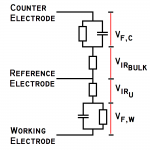 What’s important in the selection of a potentiostat? That depends greatly on its intended use. This page addresses an often misunderstood term.
What’s important in the selection of a potentiostat? That depends greatly on its intended use. This page addresses an often misunderstood term.
Compliance voltage
Compliance voltage is the voltage available at the counter electrode that can be used to force current to flow and still maintain control of the working electrode voltage. The compliance should be specified in conjunction with a current value: “20V @ 250mA” or “20V @ full rated current”. An amplifier’s output voltage decreases at higher currents due to the output impedance of the amplifier.
The voltage at the counter electrode is needed to force the electrochemical reaction at the counter electrode to proceed and to overcome the iR drop through the bulk of the electrolyte solution. Compliance voltage can become important when the currents are high, or when the conductivity of the solution is low (dilute electrolytes), or when a high resistance sintered glass or Vycor® frit has been used to isolate the counter electrode.
In practice, depending on the electrolyte and cell design, the potentiostat’s useable limits may be defined by either its maximum current specification or its compliance voltage limit. In either case, if the limits are exceeded the potentiostat will be unable to properly control the voltage of the working electrode.
You can find the link to Gamry Application Notes here.
